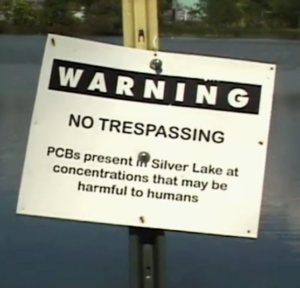Drive east along East Street in Pittsfield, and soon you will pass Silver Lake on your left. Take a left turn on Silver Lake Boulevard and you will again have Silver Lake on your left.  There’s a lot of activity there right now. The lake bottom is about to be capped to cover its contaminants. This sweeping of PCBs under the rug is what’s passing for a cleanup. Even after the “cleanup”, Silver Lake will continue to send PCBs into the section of the Housatonic River that has already been cleaned.
There’s a lot of activity there right now. The lake bottom is about to be capped to cover its contaminants. This sweeping of PCBs under the rug is what’s passing for a cleanup. Even after the “cleanup”, Silver Lake will continue to send PCBs into the section of the Housatonic River that has already been cleaned.
As you begin your drive along Silver Lake Boulevard, take a look to your right. This is the William Stanley Business Park. It’s one of the former GE sites and has been turned into a commercial property under the guidance of the Pittsfield Economic Development Authority, or PEDA. According to PEDA’s website, “PEDA is a quasi-public agency created by a special act of the Massachusetts State Legislature, for the purpose of being the recipient and redeveloper of approximately 52 acres of General Electric Company’s former industrial facility located in the heart of Pittsfield Massachusetts.”
Notice that there is a small body of water between you and the business park. This small water body was designed and constructed to catch runoff from the property. Its outlet passes under the road through a culvert and goes into Silver Lake. The problem is, the runoff being collected by this waterbody is coming from a former GE site and is contaminated with PCBs. Those PCBs are flowing into Silver Lake, and from there into the Housatonic River.
The problem for PEDA is this. Nobody, not even a quasi-public agency, can send pollutants into a lake without a permit from the Environmental Protection Agency (EPA). This is one of the major provisions of the Clean Water Act, and not even the infamous Consent Decree can exempt PEDA from this provision of the federal statute. Complying with this law could be expensive. The permit will likely require monitoring and may require some form of remedial activity.
But BEAT doesn’t think PEDA has much to worry about. The document by which the property was transferred from GE to PEDA is called the Definitive Economic Development Agreement, or DEDA. This document states, “If the contamination migrating off-site is of the same nature as that known as of the date of transfer, it shall be presumed to be caused by GE unless GE demonstrates that PEDA or a future user not controlled or invited on or otherwise allowed to enter the Transferred Property by GE caused such contamination;”. BEAT interprets this to mean that if PCBs are migrating off site and flowing into Silver Lake and the Housatonic River, they are GE’s responsibility, not PEDA’s.
What does PEDA have to say about this? BEAT has met with PEDA officials and they have not disagreed with our interpretation. However, they are not going to pursue this opportunity to pass the cost of complying with the Clean Water Act on to GE. Their reason? They don’t want to incur the legal cost of calling their lawyer and asking for an opinion. Instead, PEDA is asking their lawyer to contact EPA and request that PEDA not be made to comply with permitting regulations.
BEAT has spoken with EPA officials about this. Their position seems fair. They are requiring the current occupant, PEDA, to comply with the law. If GE is legally responsible for picking up the tab, it’s up to PEDA to pursue them legally.
BEAT’s discussions with PEDA officials and with EPA lead us to believe that PEDA will be held accountable under the Clean Water Act, and unless PEDA decides to take some legal initiative, the bill will be paid from PEDA’s quasi-public bank account.
In the latest development in this story, GE is fighting any responsibility for the PCBs flowing into Silver Lake.
So the question for all of us is, Will GE pay the bill, or will we?
